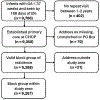Prevalence, predictors, and patterns of residential mobility by the parents of preterm infants
- PMID: 40962824
- PMCID: PMC12516164
- DOI: 10.1038/s41372-025-02414-x
Prevalence, predictors, and patterns of residential mobility by the parents of preterm infants
Abstract
Objective: Describe how preterm infants experience residential mobility, or moving, before age 2 years.
Study design: This retrospective cohort study included 9267 preterm infants followed in a mid-Atlantic urban and suburban primary care network. Multivariable regression modeling identified patient and community factors associated with residential mobility, defined by a change in Census Block Group.
Results: 2494 infants (27%) moved before age 2 years; 559 (6%) moved more than once. Extreme prematurity, compared to late prematurity, was associated with increased odds of mobility (aOR 1.26, 95% CI 1.03-1.54). Governmental insurance, male sex, a positive or missing post-partum depression screen, and neighborhood deprivation were also positively associated with mobility. Among movers, 741 (30%) first relocated before 6 months of age, and mobility rates decreased with increasing chronologic age.
Conclusion: Early-life residential mobility is common among preterm infants, particularly extremely preterm infants. These findings have implications for discharge preparation among this vulnerable group.
© 2025. The Author(s), under exclusive licence to Springer Nature America, Inc.
Conflict of interest statement
Competing interests: The authors declare no competing interests.
Figures



References
-
- Amoah DK, Nolan V, Relyea G, Gurney JG, Yu X, Tylavsky FA, et al. Factors associated with residential mobility during pregnancy. Women Health. 2018. Sep;58(8):955–66. - PubMed
-
- Margerison-Zilko C, Cubbin C, Jun J, Marchi K, Braveman P. Post-partum Residential Mobility Among a Statewide Representative Sample of California Women, 2003–2007. Matern Child Health J. 2016. Jan;20(1):139–48. - PubMed
-
- Saadeh FB, Clark MA, Rogers ML, Linkletter CD, Phipps MG, Padbury JF, et al. Pregnant and moving: understanding residential mobility during pregnancy and in the first year of life using a prospective birth cohort. Matern Child Health J. 2013. Feb;17(2):330–43. - PubMed
-
- Meeker JR, Burris H, Boland MR. An algorithm to identify residential mobility from electronic health-record data. Int J Epidemiol. 2022. Jan 6;50(6):2048–57. - PubMed
Grants and funding
LinkOut - more resources
Full Text Sources

